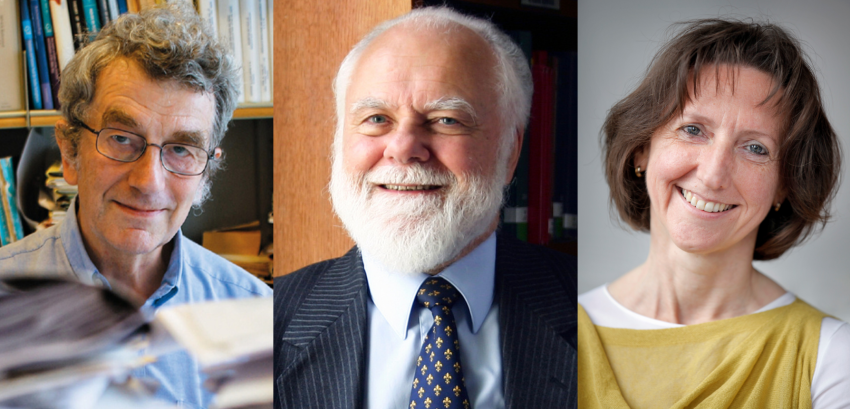For more than 200 years the nursery rhyme "Twinkle, Twinkle, Little Star" has posed a question astronomers have struggled to answer.
But thanks to three Fellows of the Royal Astronomical Society, we are now unlocking the secrets of just 'what stars are' and what is hidden inside them.
This groundbreaking work has been recognised with the awarding of the prestigious Crafoord Prize in Astronomy 2024 to Douglas Gough, Professor Emeritus at the University of Cambridge, Jørgen Christensen-Dalsgaard, of Aarhus University in Denmark, and Conny Aerts, of KU Leuven in Belgium.
The trio have been honoured by the Royal Swedish Academy of Sciences - which is also responsible for selecting the annual Nobel Prize winners - for uncovering "secrets inside the Sun and stars" and “bringing us new knowledge about phenomena that cannot be perceived by the human eye”.
Bengt Gustafsson, Professor Emeritus at Sweden’s Uppsala University and a member of the prize committee, said the laureates had given us the ability to answer the 19th century lullaby's question 'How I wonder what you are!' “by establishing an entirely new field of research, which studies the way that stars ‘twinkle’".
Of course, the main cause of the twinkling of stars we see from our perspective on Earth is because of the way their light passes through our atmosphere.
The twinkling referred to in this research is due to seismic waves in the stars, which is a much smaller effect.
The three scientists were recognised for discovering that methods used by seismologists to learn about earthquakes on Earth could also be applied to astronomy.
This so-called asteroseismology allows scientists to study the interior of the Sun and stars by monitoring movements on their surfaces caused by internal oscillations similar to soundwaves.
When Professor Gough started his theoretical work, he focused on the Sun and soon had the assistance of his doctoral student, Professor Christensen-Dalsgaard.
The pair, along with hundreds of other researchers, went on to establish a network called the GONG telescopes in 1995, which led to a series of new discoveries such as how the interior of the Sun rotates differently to its outer layer.
Professor Aerts used the same method to learn more about distant stars.
Thanks to this new technology, researchers are now able to measure the radius of stars and the composition of their interiors and to give them a more precise age.
“Twinkle, twinkle, little star, / how I wonder WHAT you are!” is the text of a well-known nursery rhyme,” said Professor Emeritus Gustafsson.
“Small changes that we perceive in a star’s brightness are also due to the oscillations in its interior.
“By establishing an entirely new field of research, which studies the way that stars ‘twinkle’, the laureates have given us the ability to answer the nursery rhyme’s question.
“We can learn more about the stars’ structure and rotation, as well as about the history of the Milky Way.”
Professor Mike Edmunds, president of the Royal Astronomical Society (RAS), congratulated all three RAS Fellows on their prize.
“The award of the Crafoord Prize this year to pioneers in the field of asteroseismology is very welcome, particularly since the three winners are Fellows of the Society,” he said.
“They have made a major contribution to the study of the Sun and stars. I am particularly delighted that one of them is my long-standing colleague Douglas Gough.
“I had the good fortune to learn all about stellar physics from his excellent graduate lectures when I was a research student.
“Many congratulations to all three.”
Media contacts
Sam Tonkin
Royal Astronomical Society
Mob: +44 (0)7802 877700
Robert Massey
Royal Astronomical Society
Mob: +44 (0)7802 877699
Images and captions
Douglas Gough - Credit: Institute of Astronomy
Jørgen Christensen-Dalsgaard - Credit: Rasmus Roerbaek
Conny Aerts - Credit: Rob Stevens
Notes for editors
About the Royal Astronomical Society
The Royal Astronomical Society (RAS), founded in 1820, encourages and promotes the study of astronomy, solar-system science, geophysics and closely related branches of science. The RAS organises scientific meetings, publishes international research and review journals, recognises outstanding achievements by the award of medals and prizes, maintains an extensive library, supports education through grants and outreach activities and represents UK astronomy nationally and internationally. Its more than 4,000 members (Fellows), a third based overseas, include scientific researchers in universities, observatories and laboratories as well as historians of astronomy and others.
The RAS accepts papers for its journals based on the principle of peer review, in which fellow experts on the editorial boards accept the paper as worth considering. The Society issues press releases based on a similar principle, but the organisations and scientists concerned have overall responsibility for their content.


